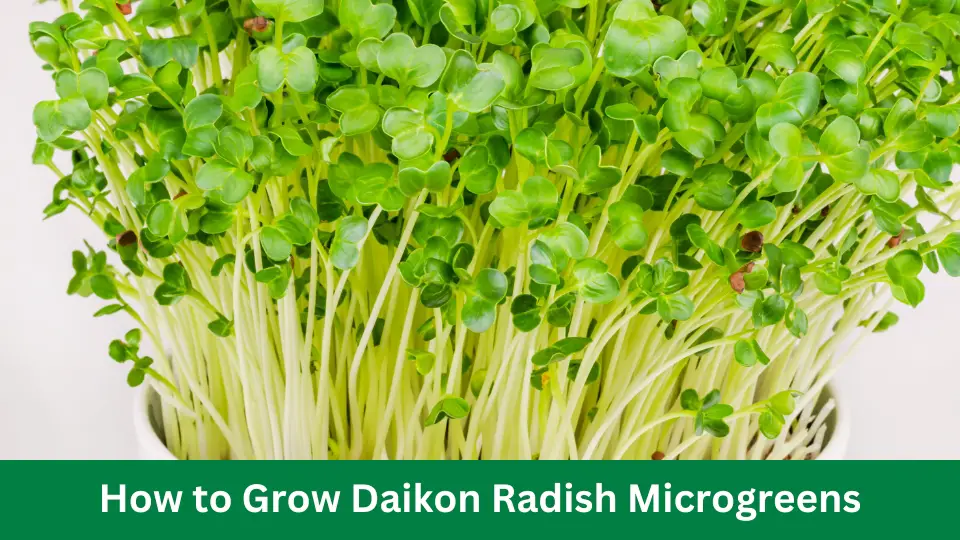To grow daikon radish microgreens, soak the seeds overnight, spread them evenly on a shallow tray filled with organic soil, mist them with water daily, and harvest them after 7–14 days when they reach a desired height. Daikon radish microgreens are a nutritious and delicious addition to salads, sandwiches, and stir-fries.
These vibrant greens are packed with vitamins, minerals, and antioxidants, offering a punch of flavour and a range of health benefits. Growing your microgreens is a rewarding and cost-effective way to enjoy fresh produce year-round. With just a few simple steps, you can cultivate an abundance of daikon radish microgreens in your home.
We will guide you through growing daikon radish microgreens from seed to harvest. Get ready to elevate your meals with these vibrant and nutritious greens.
Preparing The Growing Container
Growing daikon radish microgreens is an exciting and rewarding gardening project that lets you enjoy these nutritious greens’ fresh, crisp flavour right at home.
To ensure successful growth, properly preparing the growing container is essential. This section will discuss selecting the container, preparing the soil, and watering the soil for optimal daikon radish microgreens cultivation.

Selecting The Container for Daikon Radish Microgreens
You have several options when selecting a container for growing daikon radish microgreens. A shallow, plastic seed tray is one of the most popular and convenient choices. These trays are lightweight and easy to handle, allowing for better control of the growing environment.
Alternatively, you can use a recycled container, such as a plastic bin or even a shallow wooden crate, as long as it has drainage holes.
Preparing The Soil for this Microgreens
The soil you choose for growing daikon radish microgreens is vital to their overall growth and development. Opt for a high-quality, well-draining potting mix that retains nutrients and moisture for healthy microgreen growth.
Fill the container with the potting mix, leaving about an inch of space from the top to prevent water overflow when watering.
Watering The Soil
Proper hydration is essential for the successful growth of daikon radish microgreens. When it comes to watering, it’s essential to strike a balance. Avoid overwatering, as excessive moisture can lead to issues such as root rot, mold, or fungal growth. On the other hand, insufficient water can stunt the growth or even kill the microgreens.

To maintain the ideal moisture level, water the soil gently with a spray bottle or a watering can with a fine misting nozzle. Aim to keep the soil moist but not soggy throughout the growing process.
Planting Daikon Radish Seeds
Knowing the proper planting technique is important to growing daikon radish microgreens. This article will cover the three key steps: soaking, sowing, and covering the seeds to ensure successful germination. Let’s dive right in!
Soaking The Seeds
To maximize the chances of successful germination, it’s advisable to soak daikon radish seeds before planting. Start by taking a clean container and filling it with warm water.
Then, add the seeds to the water, ensuring they are fully submerged. Let the seeds soak for about 8 to 12 hours. Soaking the seeds helps to soften the outer layer, allowing for easier and quicker germination.
Sowing The Seeds
Once the seeds have finished soaking, it’s time to sow them. Choose a suitable growing tray or container with drainage holes to prevent excess moisture. Fill the tray with a well-draining potting mix, leaving about half an inch of space at the top. Spread the soaked seeds evenly across the surface, ensuring they are not too close together.
Gently press the seeds into the soil, ensuring they are in contact with the moist soil. If you’re growing in multiple trays, label each tray to keep track of different varieties or planting dates.
Covering The Seeds
After sowing the seeds, cover them with a thin layer of soil or a humidity dome. The covering layer should be about 1/4 inch thick, providing protection and maintaining high humidity for better germination. Remember that some daikon radish microgreen varieties prefer darkness during germination, while others can tolerate light.
Check the specific guidelines for the variety you are growing. Maintain a warm and moist environment by misting the soil regularly or using a spray bottle. Avoid over-watering, as it may lead to damping-off, a fungal disease that can damage the young seedlings.
Once you’ve completed these three steps, it’s time to wait patiently for the magic of germination to occur. Tiny sprouts will break through the soil’s surface in a few days.
Remember to provide proper light, water, and care as your daikon radish microgreens grow. Before you know it, you’ll have vibrant and nutritious microgreens ready to add a delightful crunch and flavorful kick to your dishes!
Caring For Daikon Radish Microgreens
Caring for healthy and vibrant daikon radish microgreens is crucial when cultivating healthy and vibrant daikon radish microgreens. These tiny greens pack a punch of nutrition and flavour, making them popular among home gardeners and chefs.

To ensure the success of your microgreen project, it is essential to focus on key aspects such as providing sufficient light, watering the microgreens correctly, maintaining proper temperature, and managing air circulation.
Providing Sufficient Light
Daikon radish microgreens require an ample amount of light to thrive. Place them where they can receive 6–8 hours of direct sunlight. If sunlight is limited, you can use artificial light sources such as fluorescent or LED grow lights.
Position the lights approximately 2–3 inches above the microgreens to provide adequate light intensity. Adjust the lighting duration to mimic the natural day-night cycle to promote healthy growth.
Watering The Microgreens
Watering daikon radish microgreens properly is essential to maintaining their optimal moisture levels. Use a gentle spray bottle or mister to provide a light misting of water onto the microgreens.
Ensure that the water evenly moistens the top layer of the growing medium without creating waterlogged conditions. Overwatering can lead to rot and fungal issues. Stick to watering once or twice a day, depending on the growing medium’s environmental conditions and moisture level.
Maintaining Proper Temperature
Suitable temperature plays a vital role in the growth of daikon radish microgreens. Aim to maintain a temperature of around 70–75°F (21–24°C) for optimal growth.
Extremely hot and cold temperatures can hinder germination and overall development. Shield the microgreens from direct drafts or excessively cold areas in your home or garden.
You can promote healthy and vigorous growth in your daikon radish microgreens by providing a favourable temperature range.
Managing Air Circulation
Adequate air circulation is crucial for the health of daikon radish microgreens. Good airflow helps prevent the development of mold, mildew, and other common issues. To ensure proper air circulation, avoid overcrowding the microgreens and provide ample space between trays or containers.
You can also use a small fan to create gentle air movement. Furthermore, open windows or ventilation should promote fresh air exchange. By managing air circulation effectively, you can encourage healthy growth and minimize disease risk.
Get ready to enjoy the satisfaction of growing your daikon radish microgreens with these essential care tips. By providing sufficient light, proper watering, maintaining a suitable temperature, and managing air circulation, you can ensure the success of your microgreen project. Enjoy the experience of nurturing these nutritious and delicious greens from seed to harvest!
Harvesting Daikon Radish Microgreens
Discover the simple steps to grow Daikon Radish microgreens and enjoy a bountiful harvest. From selecting seeds to providing optimal growing conditions, this guide will help you cultivate these nutritious and flavorful greens successfully.
Timing The Harvest
Harvesting daikon radish microgreens immediately ensures optimal flavour and nutrient content. These delightful greens are ready to be harvested when they reach a height of about 2–3 inches and have developed their first set of true leaves.

This usually takes around 10–14 days after sowing the seeds. Keep a close eye on their growth to avoid harvesting them too early or late.
Cutting The Microgreens
When cutting daikon radish microgreens, you have two options: scissors or a sharp knife. Whichever tool you choose, ensure it is clean to prevent contamination. The best way to harvest these delicate greens is to snip them off right above the soil line.
Start from one side of your tray and work your way across, giving each microgreen individual attention. Remember to handle them gently to avoid bruising or damaging the leaves.
Cleaning And Storing
Properly cleaning and storing your freshly harvested daikon radish microgreens is essential for maintaining quality and extending their shelf life.
Rinse the greens under cold, running water to remove debris or dirt. Shake off the excess water and pat them dry using a clean towel or paper towel. Once dry, transfer the microgreens to an airtight container lined with a paper towel to absorb any excess moisture. Store them in the refrigerator at around 35–40°F (2-4°C) to keep them fresh for 7–10 days.
Look at the Table
| Steps | Description |
|---|---|
| 1. Rinse under cold, running water | Gently wash the microgreens to remove any debris or dirt. |
| 2. Pat dry with a clean towel or paper towels | Shake off excess water and gently pat the microgreens dry to remove any remaining moisture. |
| 3. Transfer to an airtight container | Place the microgreens in an airtight container lined with a paper towel to absorb excess moisture. |
| 4. Store in the refrigerator | Keep the container of microgreens in the refrigerator at a temperature of 35–40°F (2-4°C) to maintain freshness. |
| 5. Shelf life | Properly stored, daikon radish microgreens can stay fresh for up to 7-10 days in the refrigerator. |
Finding and harvesting daikon radish microgreens is an exciting and rewarding process. You can enjoy these nutritious greens in their prime by timing the harvest correctly, cutting the microgreens with care, and storing them properly.
Whether you plan to add them to salads, sandwiches, or smoothies, the crisp and vibrant flavour of daikon radish microgreens is bound to elevate your culinary creations. So go ahead and embark on this microgreen adventure, and experience the joy of growing your fresh produce!
Frequently Asked Questions Of How To Grow Daikon Radish Microgreens
Can You Grow Radishes As Microgreens?
Yes, radishes can be grown as microgreens.
How Do You Grow Radish Daikon Sprouts?
To grow radish daikon sprouts, soak the seeds in water for 8-12 hours. Spread the seeds evenly on a tray lined with a moist paper towel. Keep the tray in a warm and well-lit area. Water the seeds daily, making sure to keep the paper towel moist.
Harvest the sprouts in about 5-7 days when they reach the desired length.
Can You Eat Too Many Radish Microgreens?
Eating too many radish microgreens can lead to digestive issues due to their high fiber content.
Last Decision
Growing daikon radish microgreens can be a rewarding and beneficial endeavour. By following the steps outlined in this guide, you can cultivate these nutrient-rich greens in the comfort of your own home. From preparing the seeds to harvesting the microgreens, every stage of the process contributes to your success.
Remember to provide adequate light, moisture, and ventilation for optimal growth. Embrace the freshness and flavour of daikon radish microgreens by incorporating them into your favourite dishes and enjoying their numerous health benefits.
Video Source Link: https://www.youtube.com/watch?v=Yo-xyLBcBzo



